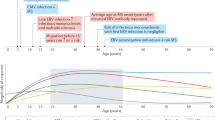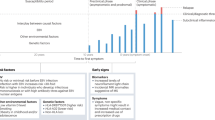Abstract
Epstein-Barr virus (EBV) is one of the most common and successful human viruses, infecting more than 90% of the world’s adult population. Despite its strong tumorigenic potential, most virus carriers remain healthy due to maintenance of a delicate balance between the host’s immune system, which limits production of virus particles, and the virus, which persists for the duration of the host’s life. New data show that this balance is altered on a subtle level in patients with multiple sclerosis (MS) and other autoimmune diseases who show enhanced as well as less restricted T-cell and antibody responses to EBV-encoded antigens. Such quantitatively and qualitatively distinct immune responses and the virus’ unique ability to immortalize B cells as well as to continuously stimulate strong T-cell responses during persistent infection suggest a possible role for EBV in the initiation and progression of symptomatic autoimmunity. We hypothesize that EBV promotes both autoimmune B and T-cell responses. EBV gene products might stimulate cross-reactive autoimmune B cells directly or increase their survival after infection. In addition, autoimmune T cells could be maintained via molecular mimicry between autoantigens and EBV antigens, and via the Th1 polarizing cytokine milieu of protective antiviral T-cell immunity. A better understanding of how EBV and EBV-specific immune control mechanisms interfere with the evolution of autoimmunity may generate a rationale for novel EBV-targeting therapeutic strategies aimed at the prevention and more efficient treatment of autoimmune diseases.
Similar content being viewed by others
References and Recommended Reading
Sospedra M, Martin R: Immunology of multiple sclerosis. Annu Rev Immunol 2005, 23:683–747.
Kurtzke JF: Epidemiology and etiology of multiple sclerosis. Phys Med Rehabil Clin North Am 2005, 16:327–349.
Sibley WA, Bamford CR, Clark K: Clinical viral infections and multiple sclerosis. Lancet 1985, 1:1313–1315.
Khan G, Miyashita EM, Yang B, et al.: Is EBV persistence in vivo a model for B cell homeostasis? Immunity 1996, 5:173–179.
Callan MF, Annels N, Steven N, et al.: T cell selection during the evolution of CD8+ T cell memory in vivo. Eur J Immunol 1998, 28:4382–4390.
Callan MF, Tan L, Annels N, et al.: Direct visualization of antigen-specific CD8+ T cells during the primary immune response to Epstein-Barr virus in vivo. J Exp Med 1998, 187:1395–1402.
Tan LC, Gudgeon N, Annels NE, et al.: A re-evaluation of the frequency of CD8+ T cells specific for EBV in healthy virus carriers. J Immunol 1999, 162:1827–1835.
Tan LC, Gudgeon N, Annels NE, et al.: A re-evaluation of the frequency of CD8+ T cells specific for EBV in healthy virus carriers. J Immunol 1999, 162:1827–1835.
Schoenberger SP, Toes RE, van der Voort EI, et al.: T-cell help for cytotoxic T lymphocytes is mediated by CD40-CD40L interactions. Nature 1998, 393:480–483.
Bennett SR, Carbone FR, Karamalis F, et al.: Help for cytotoxic-T-cell responses is mediated by CD40 signalling [see comments]. Nature 1998, 393:478–480.
Schoenberger SP, Toes RE, van der Voort EI, et al.: T-cell help for cytotoxic T lymphocytes is mediated by CD40-CD40L interactions [see comments]. Nature 1998, 393:480–483.
Ridge JP, Di Rosa F, Matzinger P: A conditioned dendritic cell can be a temporal bridge between a CD4+ T-helper and a T-killer cell [see comments]. Nature 1998, 393:474–478.
Cardin RD, Brooks JW, Sarawar SR, Doherty PC: Progressive loss of CD8+ T cell-mediated control of a gamma-herpesvirus in the absence of CD4+ T cells. J Exp Med 1996, 184:863–871.
Zajac AJ, Blattman JN, Murali-Krishna K, et al.: Viral immune evasion due to persistence of activated T cells without effector function [see comments]. J Exp Med 1998, 188:2205–2213.
Paludan C, Bickham K, Nikiforow S, et al.: Epstein-Barr nuclear antigen 1-specific CD4(+) Th1 cells kill Burkitt’s lymphoma cells. J Immunol 2002, 169:1593–1603.
Paludan C, Schmid D, Landthaler M, et al.: Endogenous MHC class II processing of a viral nuclear antigen after autophagy. Science 2005, 307:593–596.
Evans AS: The spectrum of infections with Epstein-Barr virus: a hypothesis. J Infect Dis 1971, 124:330–337.
Operskalski EA, Visscher BR, Malmgren RM, Detels R: A case-control study of multiple sclerosis. Neurology 1989, 39:825–829.
Lindberg C, Andersen O, Vahlne A, et al.: Epidemiological investigation of the association between infectious mononucleosis and multiple sclerosis. Neuroepidemiology 1991, 10:62–65.
Thacker EL, Mirzaei F, Ascherio A: Infectious mononucleosis and risk for multiple sclerosis: a meta-analysis. Ann Neurol 2006, 59:499–503.
Hjalgrim H, Askling J, Rostgaard K, et al.: Characteristics of Hodgkin’s lymphoma after infectious mononucleosis. N Engl J Med 2003, 349:1324–1332.
Alotaibi S, Kennedy J, Tellier R, et al.: Epstein-Barr virus in pediatric multiple sclerosis. JAMA 2004, 291:1875–1879.
Pohl D, Krone B, Rostasy K, et al.: High seroprevalence of Epstein-Barr virus in children with multiple sclerosis. Neurology 2006, 67:2063–2065.
Levin LI, Munger KL, Rubertone MV, et al.: Temporal relationship between elevation of epstein-barr virus antibody titers and initial onset of neurological symptoms in multiple sclerosis. JAMA 2005, 293:2496–2500.
Ascherio A, Munger KL, Lennette ET, et al.: Epstein-Barr virus antibodies and risk of multiple sclerosis: a prospective study. JAMA 2001, 286:3083–3088.
DeLorenze GN, Munger KL, Lennette ET, et al.: Epstein-Barr virus and multiple sclerosis: evidence of association from a prospective study with long-term follow-up. Arch Neurol 2006, 63:839–844.
Sundstrom P, Juto P, Wadell G, et al.: An altered immune response to Epstein-Barr virus in multiple sclerosis: a prospective study. Neurology 2004, 62:2277–2282.
Thorley-Lawson DA: Epstein-Barr virus: exploiting the immune system. Nat Rev Immunol 2001, 1:75–82.
Rickinson AB, Moss DJ: Human cytotoxic T lymphocyte responses to Epstein-Barr virus infection. Annu Rev Immunol 1997, 15:405–431.
Cohen JI. Epstein-Barr virus infection. N Engl J Med 2000, 343:481–492.
Williams H, Crawford DH: Epstein-Barr virus: the impact of scientific advances on clinical practice. Blood 2006, 107:862–869.
Colombo M, Dono M, Gazzola P, et al.: Accumulation of clonally related B lymphocytes in the cerebrospinal fluid of multiple sclerosis patients. J Immunol 2000, 164:2782–2789.
Colombo M, Dono M, Gazzola P, et al.: Maintenance of B lymphocyte-related clones in the cerebrospinal fluid of multiple sclerosis patients. Eur J Immunol 2003, 33:3433–3438.
Cepok S, Zhou D, Srivastava R, et al.: Identification of Epstein-Barr virus proteins as putative targets of the immune response in multiple sclerosis. J Clin Invest 2005, 115:1352–1360.
Bray PF, Luka J, Culp KW, Schlight JP: Antibodies against Epstein-Barr nuclear antigen (EBNA) in multiple sclerosis CSF, and two pentapeptide sequence identities between EBNA and myelin basic protein. Neurology 1992, 42:1798–1804.
Wucherpfennig KW, Strominger JL: Molecular mimicry in T cell-mediated autoimmunity: viral peptides activate human T cell clones specific for myelin basic protein. Cell 1995, 80:695–705.
Lang HL, Jacobsen H, Ikemizu S, et al.: A functional and structural basis for TCR cross-reactivity in multiple sclerosis. Nat Immunol 2002, 10:940–943.
Lunemann JD, Edwards N, Muraro PA, et al.: Increased frequency and broadened specificity of latent EBV nuclear antigen-1-specific T cells in multiple sclerosis. Brain 2006, 129(Pt 6):1493–1506.
Gronen F, Ruprecht K, Weissbrich B, et al.: Frequency analysis of HLA-B7-restricted Epstein-Barr virus-specific cytotoxic T lymphocytes in patients with multiple sclerosis and healthy controls. J Neuroimmunol 2006, 180(1–2):185–192.
Antony JM, van Marle G, Opii W, et al.: Human endogenous retrovirus glycoprotein-mediated induction of redox reactants causes oligodendrocyte death and demyelination. Nat Neurosci 2004, 7:1088–1095.
Caldwell RG, Wilson JB, Anderson SJ, Longnecker R: Epstein-Barr virus LMP2A drives B cell development and survival in the absence of normal B cell receptor signals. Immunity 1998, 9:405–411.
Author information
Authors and Affiliations
Corresponding author
Rights and permissions
About this article
Cite this article
Lünemann, J.D., Münz, C. Epstein-Barr virus and multiple sclerosis. Curr Neurol Neurosci Rep 7, 253–258 (2007). https://doi.org/10.1007/s11910-007-0038-y
Published:
Issue Date:
DOI: https://doi.org/10.1007/s11910-007-0038-y




